How to date your bottle of cognac
Many people would like to know in what year their cognac bottle was produced. A very legimate question since prices for old cognacs are going trough the roof, but not so easy to answer. There are guidelines to help you, but be careful, it is not an exact science. For instance: from 1935 till 1964 it was mandatory in the US that bottles had the phrase ‘Federal law forbids the reuse of this bottle’, but after 1964 some new bottles were still brought on the market with this sentence on it. Another example: in 1979 the US changed from US customary system (pints, quarts and ounces) to the metric system, but only after 1981 most of the labels complied. So there is a transitional period of two years. In these years they sometimes put both measures, US customary and metric, on the bottles. But even years later you see bottles having both measurements on the bottle.
Guidelines
1. Look at the obvious
2. Try to find when a brand introduced a new feature or a new quality
3. Information on the bottom of the bottle
4. Excise tax information (metal medaillons, paper tax seals)
5. Federal law sentence (US, 1935-1964)
6. Maximum price per bottle (US, 1942-1947)
7. Französisches Erzeugnis (Germany, 1918 until 1964)
8. Tidyman symbol (1969)
9. Estimated sign or e-mark (1976)
10. Bar-code (1980s)
11. Content in US customary units, UK imperial units or metric measurements (1976-1981)
12. Standard drinks
13. Cotisation symbol (1984-2000)
14. Governmental warning (1989)
15. Green point symbol (1990s)
16. Recycling symbol (1994)
17. Pregnancy icon (2006)
1. The obvious
It does not always have to be difficult. When a bottle is especially made to celebrate an anniversary or commemorate a historic event, the date of that event will be stated on the bottle and that obviously is the year the bottle was produced. There are numerous examples: the silver jubilee of the Queen (Martell bottle 1977), the battle of Freedland (Napoleontic war in 1807, on a ceramic drum of Camus ), the election of president Obama (as the 44th president on a Hennessy bottle in 2009).
But a warning: some bottles had so much success that they have been produced for an extended period of time. Like the Napoléon books of Camus that initially were made in 1969 to remember his birthday in 1769. They are made in huge quantities, in several different colours, portrayed in full or just his bust, and by several different porcelain manufacturers. (I can not believe they would switch between more than two porcelain producers in just one year).
Some bottles have additional information on a card or tag hanging around the neck, like some Martell bottles (Cordon Argent or Extra and others, also some Cordon Bleu bottles).
2. Introduction dates of new bottles or features
When you can find the date of introduction of a bottle, you can certainly narrow down the period. For many old bottles this precise date is not known anymore, not even the brands themselves know, but sometimes you can find uselful information on the internet.
We know for instance that Rémy Martin introduced the Louis XIII in 1874. We also know the first Baccarat bottles of the Louis XII were made around 1900. The bottles with a white top were made until 1981 and the bottles with the golden tops started in 1979.
On my bottle catalog pages I have collected as many different botttles as I could find and put them in some sort of logical order. When the date of a bottle was given or if I just knew it, I have put it there. So you could try to find your bottle in these catalogs.
Besides different features of the bottles, other changes occur during the years. Very important indicators of the age of a bottle are the boxes in which they were sold.
Some brands issue limited editions every year. Like Hennessy VS, VSOP and XO limited editions or Rémy Martin Cannes Festival editions. These years are well known to the collectors.
For one quality several different bottle shapes have possibly been used or different labels. Take a look at these VSOP’s of Bisquit.
To date a Cordon Bleu of Martell the type of cap that was used is important (amongst many other features).
3. Information on the bottom of a bottle
Useful information is to be found on the bottom of a bottle. You can sometimes find which glass manufacturer made the bottle. If it was for instance Saint Louis Cristalleries on a Louis XIII white top bottle of Rémy Martin, you know it is after 1969.
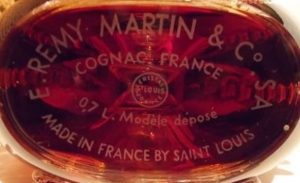
Other information can be the content, if this is not stated on the label or the back of the bottle.
Often serial numbers are put on the bottom, that correspond with certain years. This last piece of information is difficult to recover, but can be helpful as a last resort. The assistence of the manufacturer is needed though.
Sometimes you find a date, so that gives clear information. But be warned. A number of two digits not necessarily indicates a date. This is often misinterpreted. A number of four digits starting with 19 or 20 is more promissing to be a date, but not always.
4. Excise tax information
In a number of countries tax seal strips or metal medaillons were used in a specific period.
ITALY:
It is not easy to date your bottle via the tax strips or medals. There are a few problems. When new series were issued, old ones were still allowed to be used and were in fact used until they ran out. A second problem is that bottles could have been stored for some years before they got a tax strip attached and thus have gotten a newer type of tax strip. And lastly, information about the production dates of tax strips varies depending on which sources you consult. One source is the book Marche da Bollo issued by Unificato. Another source is some collectors on the Internet and a third source are the bottles themselves. These different sources contradict each other.
From 1930 till 1959 metal medals were used, but not exclusively as we shall see. First we discuss the strips, then the medals.
Tax strips
Italy started already using tax seals in 1919. Here is one example, but I have never seen them on bottles that are still around. The main text is: Tassa di bollo vini e liquori in bottiglie.
These probably were replaced with the metal medals in the early 1930s.
Then after World War Two they introduced the uni-coloured strips like these with the text: Imposta fabbricazione spiriti.
The colours varied according to the content. The most frequent was of course pink (1/2 litre until ¾ litre). They appeared in series, starting with A, up to Z and the AA up to ZZ.
First with the Savoy coat of arms but from 1949 with the emblem of the republic (with the star):
In 1950 the text changed into Imposta fabbricazione acquavite di vino. Sometimes with an indication of the age of the spirit.
The colour for ¾ litre was still pink. This green example is for a one litre bottle.
Then according to the book Marche da Bollo, in 1973 they started producing the bi-coloured strips with the emblem of the Italian Republic and two additional stars. But we see these strips being widely used from the end of the 1950s!
For ¾ litre they were red and orange with brown rosettes.
The milled edges disappeared.
Then came the light red marbled strips like this one. According to the book only in 1970, but probably a few years before (ca. 1966-67).
As you can see, the main text is now Imposta fabbricazione distillato di vino.
Then in 1977 they changed the way they indicated the content from fractions to decimals:
There were minor variations in the colour of the letters that have been used.
These strips were abandoned in 2005 (according to the book in 1999) and replaced by the blue-green ones we see today:
The main text: Accisa sull’alcole etilico – bevande alcoliche. The series are coded by three letters.
Tax medals:
From 1930 till 1959 little round metal medals were used as a seal, hanging around the neck:
Successively they were:
- Seal of Fascist Italy (sigillo Regno Fasci), used from Novembre 27th, 1933 till May 5th, 1944. It shows the shield of the House of Savoy (Sabaudo) with a crown on top and a fasces on each side.
- Seal of the Kingdom (sigillo regno), used from June 1st, 1944 till Decembre 12th, 1947. Again with the shield of the House of Savoy (Sabaudo) with a crown on top. Both fasces have disappeared and are being replaced by tendons. They are surrounded by a royal cloak.
- Headseal (sigillo testa di donna), used from Decembre 31st, 1947 till April 29th, 1949. With the arrival of the republic a woman’s head was introduced.
- Seal with star (sigillo stella), used from April 4th, 1949 till June sixth, 1959. Five-pointed star.
On the back side the content was stated, often ‘from – to’.
A small problem for dating a bottle exists because it was allowed to use old stocks of these seal until they were finished. Five-pointed star seals were seen until late in the 1960s.
So there is a substantial period of overlap where both metal medals and paper strips were used (c. 1944 – 1960).
UNITED STATES:
After prohibition ended in 1933 they started with red paper seal strips which they have been using until 1985.
Upper and lower sides of the tax strips:
- From 1934-1977 the text were : ‘US Internal Revenu’ and ‘Tax Paid’, ‘Distilled spirits’.
- After 1977 ‘US Internal Revenue’ was changed into ‘Bureau ATF’.
- From 1982 ‘Tax paid’ and ‘distilled spirits’ was replaced by Distilled’ and ‘spirits’.
wit
Near the eagle’s feet:
- 1934-1944: non-series.
- From 1944-1960 ‘series 111’ was printed here.
- From 1961-1982 this changed into ‘series 112’.
- After 1982: non-series.
wit
At the end of the strips:
- From 1934-1960 the content was given on both ends of the strips.
- From 1961 this place was left empty.
After 1985 they stopped using tax seal strips in the US.
UNITED KINGDOM:
The UK started to use the little round stickers in 2006. Sometimes they are part of the label design on the back side.
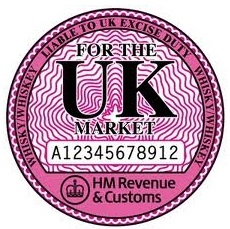
Sometimes bottles that are older than 2006 have a sticker if they are passed through a UK retailer or bonded warehouse.
5. The Federal Law sentence
In 1935 the US ordered to have the following phrase stated on each bottle: “Federal law forbids the reuse of this bottle”. Almost always this sentence was embossed on the glass, but is could also be printed on the label.
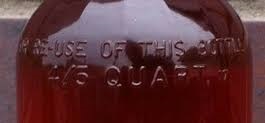
After 1964 this decree was lifted. So if the bottle does not have this phrase and it is not from before 1935, it is very probably after 1964. But be informed that some people – though very rare – have seen bottles as late as 1970 with the phrase still on the bottle. It is not an exact science.
![]()
6. Maximum price per bottle
During the Second World War, prices in the United States rose uncontrollably. To combat this, the General Maximum Price Regulation Act came into force on 30 January 1942 and the Emergency Price Control Act on 28 April 1942. During this period, maximum prices per bottle were stated on the bottle. These laws were repealed on 30 June 1947.
7. Französisches Erzeugnis
In Germany it was mandatory from 1918 (after WW-I) until 1964 to state the origin of the product. For cognac from France, therefore, ‘Fransösisches Erzeugnis’ was indicated on all bottles. Sometimes on the front and sometimes on the back. But it didn’t really stop after 1964 so you can see it until the 1990s.
8. The tidyman symbol
The Tidyman symbol was invented in the US in the 1950s. It is introduced in the UK in 1969. It is now used in several countries, but it is voluntarily. Variations on the tidyman symbol exist, like the tidyman glass symbol.
9. Estimated sign or e-mark
It was introduced in 1976 by a EU-directive and is still in use in the European Union.
10. Bar-code
The Barcode was invented by George Laurer in 1973 and introduced in the US in 1974. It became widely used from the 1980s onwards. In the 1970s an 8-digit code has been used, but now it is always 12- or 13-digit.
In European countries, the EAN-13 is used. This was invented in 1974 and is fast becoming the standard for the whole world. Only the US and Canada use the 12-digit UPC code.
So a bottle with a EAN-13 or UPC barcode is definitely from after 1980 and without such a code from before 1985.
11. Content in US customary, UK imperial or metric measurements (1979-1981)
In both the US and the UK, systems for measuring bottle contents were in use that differed from the metric system more commonly used in Europe. In the US, this transition started as early as 1976, in the UK not until 1979.
In the US a law was passed by President Ford in 1975, the metric conversion act, to regulate this transition. From 1-1-1976 a voluntary transition already started. In the years 1979 and 1980 a transition period was in force. From 1981 onwards it was compulsory in the US to state the contents in litres, centilitres or millilitres on every bottle.
During the transitional phase, one could come across bottles that stated their contents according to the old system, according to the new system, or both at the same time. But also for many years after 1980, both systems were used next to each other on the bottle.

In the UK the transition period took longer because only after 1995 it was mandatory to have the content in metrics. Though it must be said that most ‘goods’ used prescribed units (i.e. metrics) already in 1980; but not all and I do not know precisely about alcoholic goods.
Other countries, Australia, New Zealand and South Africa, completed the change in 1980.
Another little problem re the UK measurements is they used to subtract 20ml from the volume to put on the labels. So a 70cl bottle got a label stating 68cl and a 25.2 fl.oz. bottle a label saying 24 fl.oz. The reason behind this was that it was a serious violation to sell a bottle with less content than was stated on the label. So to be sure they put a lower number on it. This habit slowly started to disappear when the UK joined the European Union in 1973, but can be seen on bottles until 1980.
In the US the standard bottle size was 1/5th of a gallon, so when they transitioned to the metric system (1-1-1979) the standard bottle size became 750ml, which is as close to a fifht gallon as possible. In most parts of the world this was the standard. But in 1990 the European Union choose 700ml as the standard for liquor bottles and 750ml for wines.
12. Standard drinks
In the nineteen-eightees the ‘standard drinks’ were invented. So if printed on a bottle it surely is after 1980.
13. Cotisation symbol
The cotisation symbol was used between 1984 and 2000.
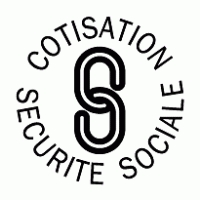
14. Governmental warning
From 1989 on it is mandatory in the US to put the governmental warning on bottles containg alcohol.
15. Green point symbol
It was invented in Germany in 1990. A bottle with this symbol therefore is after 1990. It is also known as Green Dot Symbol.
The green point symbol does not necessarily have to be green. The pictogram consists of two intertwined arrows.
16. Recycling symbol
The recycling symbol was invented in 1970 for World Earth Day but is used on liquor bottles since 1994 to indicate that the bottle is capable of being recycled. There are several variations of the symbol. It is also known as Mobius loop.
17. Pregnancy icon
This icon is voluntarily used by producers. In use since 2006. Obligatory in France since 2007.

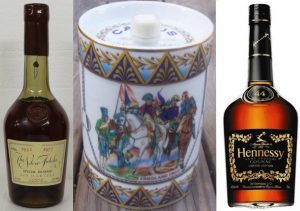
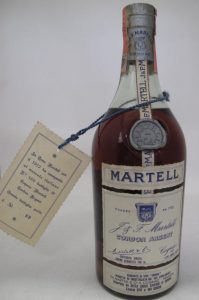

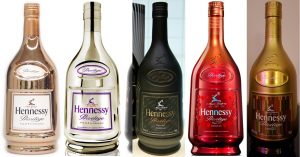
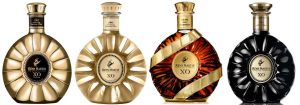
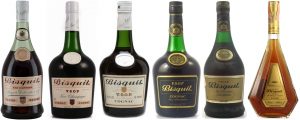
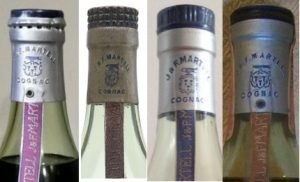


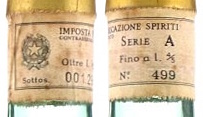





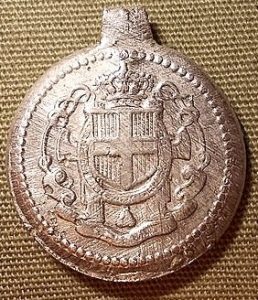
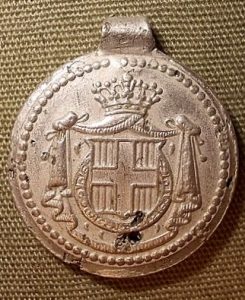
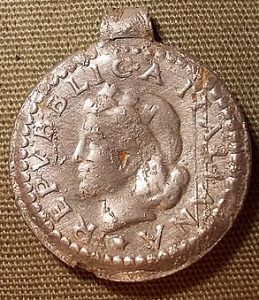
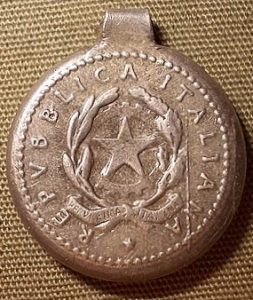

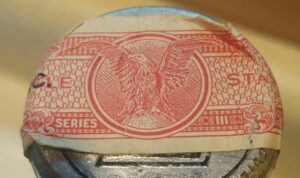

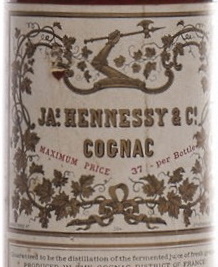
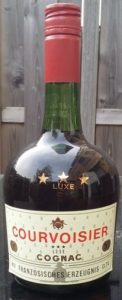
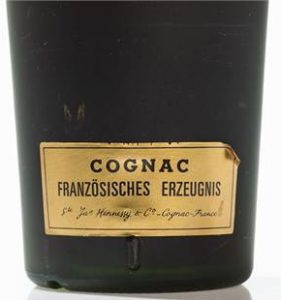
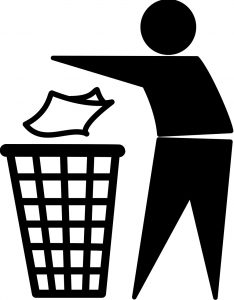
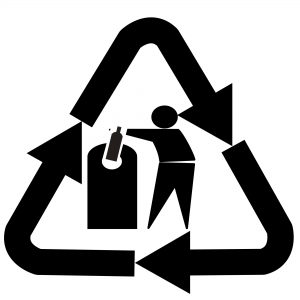
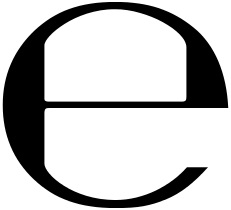
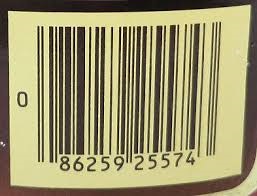
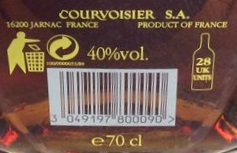
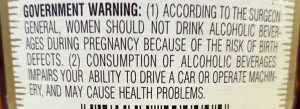

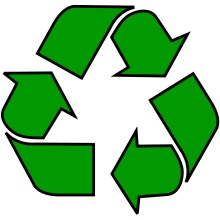

Hi,
A bit of an odd request, perhaps, but I would value help as I am struggling to determine the date of this (empty) bottle of Hennessy three star. So far I have tracked down an image of a bottle of EXTRA apparently from 1923-9, which has similar labelling (the distinctive rear label being the same, but in French). I ask, since I recovered this the other day from the roof of the Blackfriars (St Andrew’s Hall) in Norwich, and a date would be useful to pin down some otherwise undated repairs.
Cheers,
Roland
And here’s a view of the bottom of the bottle, in case it helps.
Cheers,
Roland
Hello Roland,
That is a difficult question. I searched the internet for advertisements, but I did not find any from before 1930. Moreover, I asked on a website when the paper Hennessy band above the main label started and when they started this back label, but I got no answer. So I guess no one knows exactly.
I did discover that sometime in the early 1930s they switched to using a cork with cap instead of a driven cork. By the looks of it, your bottle had a driven cork, judging by the mouth and lip of the bottle.
The back label gives some clues: the one star is indicated, as is the VO and Extra. The Extra started in 1923 as you already said. I have not seen a one star bottle up to now, so that to me that is clue that your bottle is not a 1930s, but rather an early 1920s.
Sorry that I can’t be more precise.
Kind regards,
Ton
Hello Ton,
Thanks so much: that is very useful. Confirms – and slightly narrows – my suspected dating: just need to see if I can find other evidence for the exact date of roofing works in the 1920s. Good to see that roofers at that date had such a taste at such a height, but it strikes a distant chord: one hot summer in our early 20s my wife and I were re-roofing a farmhouse near Lascaux, up on the rafters quenching thirst from enamel mugs with what we thought was slightly alcoholic fruit juice, from the local farm. Looked up this drink – Pineau des Charentes – when back in the UK, and were surprised by the price and alcohol content: a testament to a clean combination of Cognac eau-de-vie and unfermented grape juice, I guess. Still one of our favourites! Sorry for the rambling aside!
Cheers,
Roland
Yes, pineau is very famous, but almost exclusively in France. I don’t think they export it, although almost every bouilleur de cru also makes his own pineau.
By the way, did you know that there are also very expensive pineaux? François Premier in Angeac-Charente has some very old pineaux and they cost several hundreds of euros per bottle.
Cheers,
Ton
Pineau has got much harder to find in the UK over the last few decades (back in the early to mid 90s you could buy it in supermarkets here), which is a real pity, so it’s at the top of my list to buy when in France. I’ve not come across such expensive versions: I usually see it around 10 euros these days!
Anyway, thanks again for your help with the bottle dating: much appreciated.
Cheers,
Roland
Salignac Congnac. I am assuming 1980s but not sure when
Probably yes. I think this bottle is a bit different from the one I have in section 4, the first bottle.
I would like to have a photo of it showing it standing upright, not from above.
I will send you an e-mail to make this easier.
It is not possible to narrow that down to a precise year. Sorry.
Hi! Love this page and all the work you put in!
I bought this bottle of Hennessy extra at auction last year for €500. I guess it’s from the 1920’s-30’s, what do you think? I’m really torn between selling this bottle or drink it, i’ve never tasted pre phylloxera cognac before…
The estimated period is correct. It is a nice bottle with a good content level. There are not that many more of them in circulation, so when you open it, there is one less. But personally, I would still open it and drink it. Then don’t forget to let us know if you liked it.
I have been trying to date this bottle but have not found any exact match pictures of the bean shaped label with metric measure AND 40% alcohol. There is no serial number on the bottom but it matches some pictures of 1962 1963 bottles with the 7.0L marked, deposee cast in the bottle. Made in France by Baccarat. Any ideas?
I have put a lot of information in a tabel. You can find it by going to THIS PAGE and click on “All major differences between the white tops are in this TABLE (click here).”
There is also a FINE WEBSITE here.
Hello,
I’m trying to determine the actual age of this label. The seller thinks it’s from 1848. However, I believe the year refers to the vintage, not the date the label was created. Based on what I’ve been able to find I believe it’s from the 1920’s. What do you think?
Under the barrel on the right hand side in blue ink it says 696a. I can email you a higher resolution if that’s helpful.
I don’t know how old this label is. But I can tell you that the first bottles where produced around 1850. Jules Robin is often cited as the one who first came up with this, but Martell can also lay claim to it because thye are known to have had a supply of labels as early as 1848.
Furthermore, the oldest known cognac label is one by Martell and that is from 1849 (source: Bruno Sepulchre: ‘Le Livre du Cognac. Otard was not among the first. That rules out 1848 as the label’s production year.
Looking at the bottle and the dame-jeanne pictured, I would indeed estimate that the label is younger than 1900, but that is really all I can say about it. Is it actually certain that this label was intended for a bottle? It does seem likely, but strange that I have never come across this label before.
Hi, your website is very useful. My grandad has left me a 70cl bottle of Hennessy Fine Champagne V.S.O.P, a product of France. Please could you guide me on further information i.e age and the current value of this product. Please see images. Thanks..
This one is from around 1980. It has not more value than a regular VSOP fine champagne from that era, like the ones in 3d here: Hennessy VSOP fine champagne. So around €80 I would guess.
I didn’t have this bottle on my Hennessy catalog page, so thank you for that.
Hi,
first of all, I love your website. It is so useful, thank you for all that work!
I would like to date this Paulet 1914 and was wondering when the French changed the ABV unit symbol from degree (°) to percentage (%). Do you have any idea? Could be a new list entry for your dating guidelines, maybe?
Cheers from Berlin,
Manuel
Thank you for the compliments.
These bottles were probably bottled around 1970.
As for your other question. In 1973 the OIML published the “International Alcoholometric Tables“. From then on, the complete international harmonization, using %vol or equivalent symbols, was very rapid. (equivalent symbols being: 40%ALC/VOL; 40% alcohol per volume; ALC 40% BY VOL; alc.40%vol; 40%). So around 1980 almost everyone is using %. But… mentioning Gay-Lussac can be seen on some bottles as late as 1988.
The US and the UK also made the transition from proof to %vol in this period. They completed this transaction somewhat sooner, so after 1980 proof is no longer used.
Kind regards,
Ton
Thank you for this detailed explanation and have a nice weekend!
Hi, I was just wondering if you had a date/value on this bottle I received from my Grandfather, it is in a Baccarat Crystal decanter there is a internal revenue seal with “tax paid distilled spirits” it is corked with a Baccarat crystal stopper in the original box as well. the site will only allow me to send pick of bottle
Thank you
Becki
Hi there! I am trying to find some information on this bottle of fine champagne cognac recovered from my mother in law’s father’s house after he died. We are opening and tasting it today in memory of him and I was hoping to gift her with a date but I can’t seem to find even a brand for it. Any leads?
The picture is too smal to read the text. Can you send me a larger size picture?
I’ll mail you to make it easier.
Ton
Hi!
I’m wondering if you have any idea who makes this?
I acquired it at an Estate Sale today and I am finding no information or pictures at all.
I’m afraid any other labels were possibly destroyed with whatever the box was wrapped in? The bottle is void of any markings as well. There IS a faint imprint in the wax but I can’t make it out. The bottle is full of air bubbles too?
Any information you could share would be appreciated because this has me at a total loss!
Hi,
I am sorry, but I really have no idea either.
Ton
You are awesome! Thank you for your time!
Someone told me it was French so that’s something!
The research continues!
😁
wondering about age and value of this gift from a family friend
Martell 750ml
Creation Grand Extra Cognac
75 with cursive lowercase L nd 7 SGD embossed on bottom of the left foot
Bar Code 804321 032722
They were produced from 1995 until 2006. Thereafter the outlook changed. Costed around €450-500.
I guess you didn’t see this page? Section 13.6.
Hi,I am wondering if you know how much this
bottle would be worth?
it was my Dad’s
which bottle do you mean?
Curious about this bottle. Any info would be great, thanks!
Hi,
I am not sure what you want to know about this bottle. More information about the Staub brand can be found here: STAUB.
Sélection is usually used for the lowest quality cognacs, but here it says: Cognac Sélectionné provenant de la Réserve particulière de la maison. So it is compte 5, meaning it has aged at least five years, but usually much longer.
It’s hard to put a price on it. But I would say, with any luck, between 100 and 200 euros.
Kind regrads,
Ton
Thank you. All this information is great. I wasn’t sure if I should be selling it, or enjoying it and wanted to find out beforehand. I can’t seem to upload more than one image at a time. This is the back. I do have one of the tax label which I think is 1950’s?
I was given a Courvoisier cognac that was ‘very old’ and no other information. Based on research, it’s probably from the 90s but I’m not too sure on that. The writing on it is quite faded as well. Have tried contacting the brand for information but no response from them. Hope you could give some insights. Thank you
Second half of the 1980s. See section 9 (XO Imperial) on this page: Courvoisier bottle catalog
Regards,
Ton
I was given this set sometime in the 80’s by a friend of my mother. He did not provide any information on it. I have tried various websites, chat groups and even the Hennessey website and no one has any information on it. Hoping you can provide some insight.
I have several more pictures of it but seems like I can only upload one,
It is an XO Hennessy in a Baccarat caraf from the 1970s. Good cognac.
If you google Hennessy XO Baccarat, you should find bottles in auctions.
Hello,
Do you have any idea what this bottle might be worth? (pic included)
1958(?) Martell VSOP Cognac
Sealed and the label is in pretty perfect condition given the age. The pink tax excise sticker on the top is intact and has Series III by the eagle’s feet, and say 4/5 Quart on either side. The back of the glass bottle says “Federal law forbids sale or reuse of this bottle.”
Thank you in advance for any information.
That is a beautiful bottle. At online shops they would ask crazy prices, up to €500. But if you want to sell this in an auction, it will be much less. But €200-300 would be possible. Less if just a few people are interested, more if you auction it on a good site.
This one is from between 1955-1960.
Thank you very much, I really appreciate you taking the time to respond!
Hi all, I have an older Remy Martin bottle I’m trying to get more info about. I’m guessing it’s around the late 30s, judging from the research I’ve already done. Anyone have an idea of exact age, amd value? Thanks!
1938 Remy Martin Louis XIII grand fine champagne cognac.
Hi,
Nice bottle, presumably from after World War II.
Have you looked here already: https://cognac-ton.nl/flessen-a/remy-martin-bottle-library/#Louisa ? I think your bottle is in section 11B8, but I can’t see much details on your photo.
At the start of section 11 you find links to the Louis XIII Evolution website and to an overview in the from of a table.
Hello. I have found a bottle of cognac at the back of my dads alcohol cabinet and wondered if you could estimate a year and how much it’s worth?
Please send a picture of the front.
Ton
I have the mini-bottle pictured here: https://cognac-ton.nl/wp-content/uploads/2020/05/M-3st-..cl-43-a.jpg
Any idea of date on that one? I’m guessing 1970s?
In general, does the use of 70 proof on a cognac label have anything to say about the dates? I assume it’s not actually 35% ABV, but instead using the British system of proof, which they stopped using in 1980. According to Wikipedia, the EU moved away from proof to ABV in 1973, but I’m guessing that bottles would have been labeled according to their export market?
Yes, that one is fro the 1970s. It took several years before the transition from proof to alc/vol was completed.
And yes, 70 proof is equal to 40° vol.
In the US 80 proof would be equal to 40° alc/vol.
Hi. Here is 1988 Hennessy cognac flask 375ML. I would like to know what the value would be. It has been properly stored. I’ve attached a front and back of the bottle. Thanks in advance.
details:
—-Front Labels—-
(small label)
MAISON FONDEE EN 1765
V.S
(large label)
ESTD 1765
Cognac
Hennessy
Very Special
Produced and bottle in Cognac, France
by Ja Hennessy & Co.
ALC 40%
BY VOL
(80 PROOF) 375ML
—-Rear Label—-
ESTD 1765
Hennessy
VERY SPECIAL
Schieffelin
& Somerset
New York, N.Y.
Schieffelin & Somerset
Quality Integrity Service Since 1794
Sole U.S. Distributors
UPC Code: 088112 15062
Glass Flask has FRANCE engraved
Hello Marc,
This is a 1980s bottle. VS quality is the lowest quality and there are a lot of half bottles in circulation. This one with the red and gold emblem isn’t seen much, but that will not really add to its value.
I expect you will get around €20-30 for it.
Cheers,
Ton
Hello Ton. Thanks for the reply and evaluation. If you don’t mind, I have another question. Does the quality or taste of this specific VS cognac degrade overtime? I’ve had this bottle stored in a trunk in our closet.
If the bottle is stored upright, it will not degrade easily. The quality will deteriorate if the alcohol has affected the cork because it was stored lying down.
Another possibility is that the bottle was not sealed properly and an amount of alcohol has evaporated. But then the level inside will be low, so that would be easy to see.
But normally the quality remains good for a very long time, over a hundred years.
Thank you Ton. I appreciate it.
Here is the back of the bottle. Thanks again.
details:
—-Rear Label—-
ESTD 1765
Hennessy
VERY SPECIAL
Schieffelin
& Somerset
New York, N.Y.
Schieffelin & Somerset
Quality Integrity Service Since 1794
Sole U.S. Distributors
UPC Code: 088112 15062
Glass Flask has FRANCE engraved
Hello. What a great site. I have 1988 Hennessy flask 375ml, sealed. Can you help in putting a value to this bottle? Here are the details:
—-Front Labels—-
(small label)
MAISON FONDEE EN 1765
V.S
(large label)
ESTD 1765
Cognac
Hennessy
Very Special
Produced and bottle in Cognac, France
by Ja Hennessy & Co.
ALC 40%
BY VOL
(80 PROOF) 375ML
Thanks in advance.
I have a bottle of Hennessey XO. The tax label has series 112, US internal revenue, Tax paid and Distilled Spirits. I think it was bottle between 1961-1977. Is there a way to find out the exact year? How much would a 45 plus bottle be worth
Hello Viso,
These Hennessy XO bottles provide no further clues as to when exactly they were bottled. If you have the original box, that could narrow it down a bit, but not much.
On auctions these usually go for €250-350. Could be a little more if the original box is present. But there are no guarantees!
Good luck,
Ton
Dear admin, can you please kindly share your opinion on this bottle of Remy Martin Vintage Premier Cru 1988? Do you know its value? Seems like not many info about this bottle.
1988 Vintage of Rémy Martin is particularly good. Worth its money! A few years ago you could bye this bottle for €150-200. If you can buy it for €300 it is still a good deal in my opinion.
Thanks for your info, Ton! Truly expert.
I found this old Hennessy bottle in the dirt basement (more like a dungeon!) of my current home. I have been told the house was built around 1904. Can you help me with dating this bottle and is there any value to it? The label is in rough shape. I think the glass is hand blown . No numbers or marks on the glass anywhere.
I would say that it is from the 1920s at the latest, but this photo is a bit too little to rely on. Is there no shoulder label and no cork left? Is there maybe something more legible next to ‘bottled’?
Maybe you could send me a picture of the bottle in its entirety? I will send an email to facilitate this.
Kind regards,
Ton
I’ve just inherited this bottle and I cannot find any information on it. Could you help identify it and tell me of its worth? 750ml unopened.
d’Orfin is a b-brand of Gautier that is rather unknown. This one is probably from the 1970s. It has no great value. I would expect $20-40 to be bid on an auction.
Hi would you happen to know the age of this bottle? I assume it was bought at duty free in an airport hence the Nadi airport Fiji part? Guessing 70s-80s. Do they get much at auction? Thanks
Yes, this is 1970-80s. You can expect a price between €35-65. Is it 0,7L or 1 Litre?
I would very much like to have a better photo from the whole bottle, this one is a bit deformed be course it is taken from below. Is that possible?
where can I find info on a bottle of brandy Presidente that may me about 60 years old
I don’t know, i don’t know the brand name. It is not cognac. Although cognac is a brandy, not all brandy is cognac. Only brandies made in the cognac region are allowed to be called cognac.
Enjoy reading the details, wealth of knowledge indeed. Some sections are relatively technical
In fact I will need your advice on some bottles that was offered to me but I am unsure how much it cost..
Hello David,
I can see if I can help. I don’t charge.
Ton
Good afternoon Admin
We could not trace Francet ” 2001 Vrai Millennium” XO Reserve Specialé.
Please let us know about it.
Thank you very much for you kind attention.
Please see more information.
Thank you All very much
In 1975 this brand was owned by Staub. As of 1985 it is owned by Camus.
I have no other information about this brand.
Thank you very much Admin, we sincerely appreciate it. God bless.
Hello!!! This is an unopened bottle of Courvoisier from my great uncle’s home. I’ve had it for about 20 years. I’m curious about it’s age, worth, and if it’s still good to drink! As long as I’ve had it, it’s been stored upright in a cabinet. Thank you!
Hello Allison,
These bottles with screw cap are from the 1970s. The cognac will still be good for consumption, but VS is the lowest grade of cognac and is intended to be used for mixing, not to drink straight.
The worth is €40-60, so $45-67 in an auction.
Kind regards,
Ton
Hi I found this at home and is bought by my grandpa but he has already passed on so are you able to help me tell which year of Remy Martin XO cognac is this?
Great thanks in advance
Hello,
If you look at the Remy Martin bottle catalog page, section 7b2, you’ll find that these bottles were produced from the late 1980s till the early 1990s. It is almost impossible to narrow it down any further, unless there is specific additional information about the year on the bottle, like a duty seal or a punctured date or something like that.
Kind regards,
Ton
Could i get an appraisal or any information about the bottle? no back label, box is here says “extra” instead of xo
more photos available
This bottle is from the second halve of the 1970s. A few years ago these bottles were sold for €250-500 or so. Prices have gone up though, so you see shops offering them for prices up to €1.000 and even above.
If you try to sell this on an auction I think you can expect €500-700, but you have to have to have a little bit of luck. That is to say, more people who are willing to bid against each other. Then even more is feasible.
I like to see some more photo’s, also photos of the box, so I’ll send you an e-mail to make this easier.
Ton
Dear Tom, I have acquired (what I believe is) an extremely old Martell & Co open bottle of cognac. Unfortunately there is no label of any kind except for the risen glass printing on the side of the Bottle which reads, “Federal law forbids sale or reuse of this bottle:” and some thing on the bottom which states that the bottle was made in France. Could you please possibly tell me about how old this bottle might be and if it has any value? There is only less that 1/4 of the liquid (which I can only assume is cognac) left in it. Thank you for your input and knowledge in advance. Respectfully, James Edward Osment Jr.
P.S. I want to send a photo but this comment area only allows for up to 1 MB and my (not so) smartphone only takes photos which are 2MB and up
To add photos you can reduce your photos with the aid of an image and photo software program like Paint.net.
But I will send you an e-mail to facilitate things. I hope I can help you with the little information you got.
Ton
Can you tell me the age and possible price? please.
I am on holiday right now. I’ll answer end of the week.
Ton
Hi,
I have a bottle of ‘Courvoisier Napoleon Cognac with Bottle No JT6950’. Is it possible to get more information on the bottle?
Thanx
Farshid
The bottle number does not help, unless you contact Courvoisier. But I doubt they will reply. These bottles were produced in the 1980s.
Hello, I found one of my late grandfather’s Napoleon Cognac. Can you help me identify how old this might be and the price range for the condition of the bottle. Thank you!
These Napoleon bottles from Courvoisier are difficult to put a date on. These types (stopper with cork, just cognac on the label) were around from the 1950s till the 1970s and there were a lot, so the prices are not that high.
Judging by the capsule this could be 1950s. That would also explain the low level inside.
They sell in auctions for around €80-120, but I have seen them go for less than €50 too.
Thank you!
2:nd one.
BR
Christian
Hi, I found these two Hennessy bottles at a flea market a couple of years ago, they are smaller bottles, I would guess 375 ml (The label does noy show). Would you have more information about them?
Thank you in advance!
BR
Christian
The Bras d’Or is probably from the 1950s, the Bras Armé is from 1962-1963.
Nice bottles, I didn’t have them on the catalogue page.
Can you help with date on this bottle more photo i can send on e-mail
My email are przemek.o@g.pl
1980’s
Just wondering what year and what it’s worth can’t find bottle anywhere was my grandads
Is this a personalized bottle? What dies it say? Ap Petri?
May you can send me a better photo by mail, so I can read the details?
Friend of mine sent me this picture. From what I can find Champanac was purchased by or rebranded to Unicognac, who seem to have their hands in everything. Was wondering if you knew about when that transition happened so I could give my buddy a minimum guess on age.
Hello,
To me Champanac is a bit of a mystery. I have seen labels with Champanac – Jonzac and with Champanac – St. Jean d’Angély.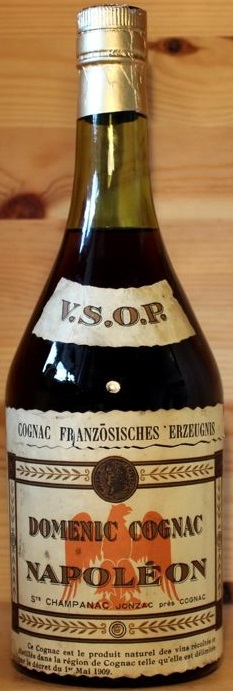
I have also seen a bottle of “Domenic Cognac” with Ste Champanac – Jonzac in the address line.
I have no real information that Champanac is taken over by Unicognac other than one person mentioning this in a comment somewhere online, but that would not really be a big surprise as they are the largest firm in Jonzac.
But I am interested to get a good photo of this bottle from top to bottom, and a good close-up of the label, so I can read the text. If your friend would be so nice, I would appreciate that very much.
Kind regards,
Ton
Hi there I’m having some trouble identifying a exact year for a bottle of Hennessy, the federal seal on top says series 112 so I would think it would be after 1961 but the seal also has the distributor information ( schieffelin & Co – New York, N.Y. ) on one side and what I’m assuming to be the bottle number (20164960) on the other and I see that you stated that they stopped putting the information on there in 1960. Thank you in advance for any help you can offer.
Hello Kevin,
So they stopped the 111 series in 1960 and started the 112 in 1961. Maybe not exactly on the 1st of January 1961, but around that time. The same goes for leaving off the information on the ends of the tax strip.
But on the end of the strip the content was printed, not the distributors name, nor a bottle number. The distributors name could have been printed on the side of the strip, but not on the very end.
So I think one can only say that the bottle is 1961 or later. But these bottles were soon after replaced by another model, so this is a 1960s bottle, not later.
Is there maybe a US State stamp on the bottle. US State stamps were changed almost on a yearly base. But you have to know these stamps and I do not, so you have to find someone else who knows about them.
Regards,
Ton
Is this worth anything it is unopened?
Sorry Ros, this is brandy, and although cognac too is a brandy, I am only familiar with cognac prices, not with other brandies like this one.
Remy Marting Cognac. We are thinking from the 60’s? Daughter cleaned out her fathers estate. We would like to sell it and proceeds donated to the animal rescue I run. Any ideas? Thank you! In it’s original wooden casing (the father tied it upside down so the cork stayed wet)
Hi Suzy,
I can’t make out the content. Looks like it says 1/2 Gallon, but I have not seen that before. Or is it 1 Gallon or 4/5 Quart? Both were produced in wooden cradles.
Cognac should not be stored lying down or upside down, because the 40° alcohol affects the cork, so that is detrimental to the quality of the cognac inside and therefore to its price.
This bottle could be end 1950s. The ‘brand cognac brandy’ text on the neck lable was used in those years.
Could you tell me the content please?
Kind regards,
Ton
Hi! It’s a half gallon. 80 proof.
“E. Remy Martin & Co.
V.S.O.P.
Brand Cognac Brandy”
That is what the top oval label says. I have cut the strings and put the bottle up right although I suppose it’s too late now! If you have any ideas of how I can get an estimation of price I would sincerely appreciate it!
Also etched in the glass in the back it said “ Federal law for bids sale or re-use of this bottle“ Which, and doing my research, seems to help identify a little bit as to when it was made
I have send you an e-mail.
Ton
Group:
I am trying to identify the year/ value of this bottle. A panorama image is attached – I am not an expert on cognac but (generally) know my way around a bottle. Other than the obvious – is there anything anyone can tell me?
There is no label on the reverse and nothing pertinent (I believe) on the underside.
Any information would be useful. I am not under the impression that this is an overly valuable bottle – just trying to identify it for a colleague to whom it was gifted in the 70s (his claim).
Thanking you all in advance.
Charles
Hi Charles,
I haven’t seen this bottle before. I would not be surprised if this is older than 70s, maybe 60s, because of the 5 star denomination, but this type of label was indeed used by Delamain in the 1970s.
Five stars was used to state that the cognac had aged more than a three star cognac, for which 2 years of ageing was a minimum. But in the 1960s en 70s other qualifications were already widely used by Delamain for their better (older) quality cognacs and 5 stars is regarded as young cognac.
I can´t make out what units were used for content and ABV. Maybe you can send me some better photos please, one of the whole bottle and a close-up of the label?
Five stars qualification is almost never used by Delamain, in fact this is the first I see. That makes it scarce, but not necessarily valuable. I would estimate this bottle to fetch around €100.
Ton
Ton:
Thank you for writing back – and in English. While I have some Dutch, it is not nearly enough to converse on specialized topics.
I am sending you two sets of joined images – separate postings. Please let me know if they suffice.
My colleague has said that it was a gift in the early 70s but he knows (remembers) nothing more. We are in Quebec, Canada, if that helps at all.
I understand about the value – not my bottle anyway and I care only if it is opened one day so that I might arrange to be around with an appropriate vessel awaiting a fill.
My thanks again.
Charles
Second set of images.
Hi again,
Sorry for the late response, I had missed your comment. Indeed, I think it may be worthwhile to be around when the bottle is opened. Delamain has an excellent reputation, so even a 5 star cognac will taste good. In the 60’s it was not unusual for star cognacs to have matured for a long time before being bottled, even three star cognacs and this is 5 star.
The photos are good but unfortunately a little small. I am sending you an email in hopes that you will send the photos in larger size so that I can put a photo on the website.
Sincere,
Ton
Me dad gave me this bottle of cognac can anyone tell me anything about it year etc
This is the box it come in
This bottle is from the 1970s. It is good quality cognac, aged long in wooden casks.
The worth has gone up in the past five years, from around €100 to €150-200 nowadays.
Ton
I have an unopened bottle of Hennessy with a date on label of 1934. Ehat would be the value approximately?
Hallo Beverly,
What kind of Hennessy, a three star?
Could you upload a photo?
Ton
Hello,
I’m looking for an approximate age of this bottle. I am guessing it is from the 50’s or 60’s.
I can’t tell without seeing the capsule.
And do you perhaps also have the box?
Ton
I do not have the box, never have.
Purchased from a duty free shop.
I still can’t make out the capsule. Looks like a screw cap, or is it a cork?
If I send you an e-mail, can you send me the photo’s?
Photo of the bottom.
The only thing I know is that the brand name now is owned by Camus.
Looking at the label I would estimate this bottle to be from the 1960s. Also because it says brandy and the word cognac is printed nowhere on the label or the cap. Probably made for the UK market.
I can’t really read the words, but it looks as if: ‘pure French brandy’ and below: ‘product of France’.
Is there a date (of establishment) to the left or right side of the emblem?
If I send you an e-mail, could you send me a better picture of the whole bottle, standing up?
Ton
Hi, can you please help me with this bottle of brandy ? There is no back label and not really much info on front one . There are numbers 07, 12 (there are 2 dots on top of it) and 17 on bottom of the bottle .I Can upload more photos if needed. Thank you very much in advance.
Looking to date this bottle from my grandfathers collection that we inherited. It does have the US internal revenue printed on the pink tax sticker on the top of the bottle. The bottom of the bottle says “liquor bottle” and has the numbers 123, 423, and 73 embossed separately into the glass.
Hi Eli,
I don’t know the date of this bottle. Looking at the cap I would say 1970s. Does the tax sticker not provide any other information? Or the vack label?
Because it says 4/5 quart it is certainly before 1980.
Ton
I’m trying to find out how old the bottle of cognac is. Could you give me any information on this?
Well, I can’t even make out what brand it is. Can you send me a better picture? I will send you an email to facilitate.
Ton
Thanks for the better pictures. So the brand name is H. Poitiers. I have heard of it, but have no further information about this brand. It is a VSOP bottle, probably from the 1960s. It also says that it is a Napoleon, which seems to contradict that it is a VSOP, but happened more often in those years. The level of filling is still good. Because the brand name is very unknown and the condition of the label is pretty bad, I would not expect people to pay more than €40 for this bottle.
The only other bottle of this brand that I ever saw is here.
The bottle is an entry in the table on this page
It looks like there is some text above ‘Französisches Erzeugnis’. If you can decipher that and it is an address line (name of a city perhaps) I would be interested to know!
Hello Sir,
Thank you for your work and for this website which is full of of beautiful archives.
I’m trying to trace the history of an old House of Cognac called Delpeuch-Joyeux. This House was created by my great great grandfather Auguste Delpeuch in the late 19th century.
I will be very grateful if you have any information (creation date, …) or pictures about the Cognac Delpeuch-Joyeux to share with me.
Staying at your disposal if you have any questions.
Best
Frederic
Hello Frederic,
I am very sorry, but I have to tell you that the only information I have about Delpeuch-Joyeux is from an old label that was on a website. This website is now closed. It belonged to Paul Ronne who died a few years ago. I happen to know that some people are trying to get this website back online because it was a true treasure for information, it contained thousands of cognac labels.
On the Delpeuch-Joyeux label that was displayed was Jarnac written as the place were the firm had its housing. There was no date of establishment on the label.
Sincere regards,
Ton
I’m trying to figure out how old the bottle of cognac is. Has a seal on the cap ,never opened, # 427813513,. Can you tell.me a out it,
Is it a Rémy Martin bottle?
Does anyone have information as to when it became mandatory to put the the volume of the contents on the bottle or its label in the UK. I have seen many older bottles that state the proof but no indication of the volume in the bottle?
Excellent question, one on which I would like to hear the answer too.
It seems that from 1970 on every bottle had the content stated. So somewhere during the 1960s I think.
Anyone knowing better?
Hi,
Have two bottles of Otard V.S.O.P. 1795 from my fatter collection. They are older than 1996 (death of my father).
Attach photo of one of them. Can you tell how old is it ?
The drop-shaped VSOP bottles are from 1980 and 1990s. This longer neck label was later than the short neck label. Check Otard catalogue section VSOP under 3d1 and 3d2. Prices on auctions vary betweeen €25 and 35.
Regards,
Ton
Hello there , and what a great website ! I love it when people are passionate about something. Can you please give me any details about this large bottle. Has the label been faked or is that just how it has aged .The contents taste good 🙂 Thank you MS
Hi Maurice,
Thanks for the compliments. Regarding your bottle I can’t be sure. It seems like I am looking at the back side of a 3.78L three star bottle?
Maybe you can send better photos by e-mail? I will send you my e-mail address.
Sincere,
Ton
Hi Ton
Kudos to your meticulous effort in hosting this fine website!
After looking through your Hennessy bottle catalog, I am not sure whether my bottle of VSOP Hennessy matches the bottle images of ‘DFS sticker’ or ‘DFS sticker in grey tints’ under the section 10b. Shoulder labels state ‘VSOP Privilege Cognac’ or ‘VSOP Privilege’.
In your opinion, would there be any difference in the values of these two bottles? For that matter, do you think there would be any difference in the values of the 1L bottles under section 10 since they are all VSOP Privilege from 1989?
I have a couple bottles of unopened Martell Cordon Bleu that I am not sure of the date after looking through your Martell bottle catalog, too. I would appreciate if I can ask you more through email. Thanks in advance.
At the moment I have a little holiday. I will answer you in a few days.
Ton
No hurry. Take your time, Ton 🙂
Take care, stay safe & enjoy your holiday with sips of cognac during this turbulent times!!! 😀
I see no differences between your bottle and the one on the website with the orange sticker. These will go for around €45 for a 70cl bottle. Prices may vary though if more than one person really wants it!
This 1L bottle could get you €60-70 maybe, if lucky.
I will send you an e-mail for questions about Martell.
Cheers,
Ton
Hi Ton,
I have an 80s unopened bottle of Courvoisier VSOP, plus two unopened 1960s bottles of Benedictine and a couple of others, also unopened. I have handled them carefully and shone a light through the bottles, there is no sediment in any. I have not cleaned the bottles. I’m interested in selling the lot if possible and I’m reasonable knowing you’d have to make a profit. I’m in Bronxville NY, please provide an email that I can contact you via. Thanks, Rick
Hello Rick,
This website is not intended for buying and selling. So I think it is best for you to find another website or an auction site. Maybe Drinks Planet?
Regards,
Ton
Hi Ton,
Not bottle-related, but I just wanted to say thanks for such a great site. I’m a historical fiction author who is putting together info for a class for other historical junkies like myself about what gentlemen drank during the Regency and I really appreciate all the info I found here. I’ll be sure to reference your site in my bibliography!
Best,
Jeannine
Thank you for the compliments. And I am honoured to be referenced.
Ton
Hi
I find this in my passed away father in law house
Nice find. If it has been standing upright and the level in the bottle has not dropped, it is a decent cognac to drink.
Cheers
Could you please tell me what year this set came out bottle number SG075D7G thank you
Hello,
Sorry, I can not. There have been numerous gift boxes, but I haven’t seen this one before. As far as I can tell (the photo is rather small) these bottles were from 1980-2000s. I can’t make out what the left bottle is, is it empty?
Maybe with some more information…
I’ll send you an e-mail to make sending photo’s easier.
Sincere,
Ton
Hi, may I know how much is this worth? Looks like a Singapore edition that has just been passed down to me.
Hi James,
This is the first 1L bottle with this dark blue label I see. The 70cl bottles are currently being auctioned for £115-160. Prices are still going up. Two years ago these bottles did £80-115 and now sometimes over £150. But you have to be a bit lucky.
This being a 1L bottle I estimate it can fetch a bit more (£140-200).
It would be nice to put a photo of the whole bottle on my Martell catalog page Martell catalog page . I will send an e-mail to facilitate.
Regards,
Ton
Hello, trying to date (and value) this bottle. Any help would be great 🙂
Hello Hannah,
Very nice bottle you have there. This is a very rare bottle, although I have seen similar bottles in auctions. But so far no auctioneer has dared to put a date of bottling on it. Going by the style of the closure and the label, I would say this is 1920-40s. These pre-phylloxera cognacs are worth quite a lot. The level of filling is okay in view if its age. I would put an estimate on it of €2.500-3.000 in Europe (maybe a bit less in the US), but you’ll know exactly what its worth once you have sold it on an auction. That is to say you have to wait how much people are prepaired to bid.
I hope you are willing to send me another photo of the bottle without the top cut off? I will send an e-mail to facilitate.
Kind regards,
Ton
We are trying to determine a value for this bottle of Hennessy that we found in our grandfather’s bottle collection. It is unopened and the back label says it was bottled in April 1934.
Hello Kathryn,
Nice bottle. I have not seen this type of closure before (look at the Hennessy bottle catalog page for known bottles: https://cognac-ton.nl/overige/flessen-a/hennessy-bottles-70cl-and-up/#VSb.)
I would like to see some more photo’s: of the closure, of the emblem above the three stars (can you make out what it says?) and of the back side. I am curious to the literal text… Does it say ´bottled´?
I hope you are willing to send them and I will send you an e-mail to facilitate.
The value of a bottle is of course determined during an auction, but bottles from the 1940s are being sold for €250-300. Almost none are from before the 1940s.
Kind regards,
Ton
Hello, I am trying to date this bottle of Courvoisier Cognac. I suspect is must be early 70’s, late 60’s. And clearly is must have been for export given the label on the back and the indication of 1 US quart on the front. Not sure if the code BA4260 is of any help.
Hallo Gerard,
A bottle very much like this one is on my Courvoisier bottle catalog page, section 7a, second to last bottle. I think these are 1970s. But I am very doubtful that yours is a US bottle. It has 1 US Quart on it, but also 945cl. In the US the transition to the metric systeem took place in 1979-1980. But there is also a transition period for the alcohol content in the US. Until 1985-1986 it was compulsory to state the alcoholic content in proof. And only from 1987 on it was compulsory to state it in percent-alcohol-by-volume. Usually the first 10 years of so after 1987 they put both the alcoholic content in ABV and in proof on the bottle.
Also it is a bit strange to have the text ‘reservé à l’exportation’ on the back in French, not in English.
Lastly: there is no paper US tax seal on top of the bottle.
My questions: how or where did you buy this bottle and … can it be Canadian maybe??? I am not too familiar with Canadian Law and bottles, but if I have some time this week I will try to look into it.
Regards,
Ton
It can’t be Canadian, because the Canadian country used the Imperial UK)system of units. One imperial quart under the Imperial system of units equals 1.14L and not 0.945L.
Other candidates are some countries in Middle-America and South-America.
But still, this very probably is a 1970s bottle.
Hello. We found this bottle years ago in a 1930s house we bought. Can you give us any information about it please? Can only seem to upload one photo. Glass at bottom inside is sloped. Glass stopper, cork around rim of neck. Number on bottom of glass is 185. Many thanks, Margie S.
Hello Margie,
Have you a brand name for me?
Reards,
Ton
I have this bottle but I don’t know how old it is. The labels are already torn off due to water but I have these embossed in the bottom. Hope you can help me.
Sorry Godfrey, that is too little to go by. I don’t even know what brand it is. Is it a Hennessy XO?
Can anyone help with dating this bottle. It has the pregnancy warning sticker on the reverse side, so likely make after 1989?
Hi William,
Because of the neck (no embossed letters) it is after 1989 for sure. The pregnancy warning sticker was first used in 2006.
If you have the box that belongs to the bottle, you can narrow it down a little. See here:
.
To tell the age by its number, you have to ask Rémy Martin, but I doubt very much if they will answer such a question.
Kind regards,
Ton
Thanks so much for the background and your fast response!
Regards,
William
Any one have an idea about this Courvoisier I recently acquired? No distinguishing governmental markings at all on the glass, obviously no dates on the labels. The stamp on the left side says “Nombre Limite No. BA4297”. There is a single label on the rear which only says “Reserve A L’Exportation”
I assume you forgot to add a photo?
I’ll sen you an e-mail to make it easier to send a decent photo.
Ton.
Ok, so this is the bottle. It is on my Courvoisier catalog page, section 7d2:
https://cognac-ton.nl/overige/flessen-a/courvoisier-bottle-library/.
These are 1950-60s bottles (maybe early 70s too, but not this one). They are being sold on Europese auction sites for about €50. On occasion they can fetch you more. I once saw a bottle go for almost €200, but that was in Canada.
Kind regards,
Ton
Hi there my wife just found this at her dads house (in the UK). Any idea when it dates from (no bar code or symbols that I can find and the volume is in imperial only. Thanks in advance!
Hello Daniel,
This bottle is 1970s. Around 1980-81 all UK bottles already had the volume stated in centiliters.
The three star was being replaced by VS, starting in the 1970s. This must be one of the first Rémy Martin VS bottles.
Kind regards,
Ton
That’s great thanks for the speedy response!
So the next question is whether we should sell it or crack it open and have a good night?
Cheers
It’s a VS quality, so the lowest. These will not bring much, you should expect €25-35.
In which case we might as well drink it!
Thanks again
Hello,
I estimate this bottle to be from the 1980s (bar code, no surgeon general safety warning, metric system). Are there any features that could provide a more exact date?
Attaching photos below.
Thank you for your time!
Hello,
No, that’s pretty accurate. After 1976 because of the bar-code and after 1980 because it is metric (if so, because I can’t read that). The boxes were in use from the late 1970s until well in the 1990s. The governmental warning sentance started 1989. There were not many other symbols on these bottles. Sometimens a cotisation symbol (from 1984), but when it’s not there it has no meaning. Maybe a tax seal, was there no US tax seal?
Regards,
Ton
Hi there ,
Any idea of the age of this bottle . It has printed T RABY 487 Cognac on the base
That is too little information for me, sorry.
It sure looks like an old bottle, possibly late 19th century?
how to understand lot code of hennnessy Ex picture ” L5 251 44 04018
Hi,
That is a very good question. I have not found anyone yet who could tell me the answer. So to know the answer you’ll have to ask the Hennessy company. Though I am not sure whether they will answer.
If anyone else knows how to interpret this code, I will be happy to hear from you.
Kind regards,
Ton
Hi Sir ,
Can u share about the year of bottle ?
I purchased this bottle at auction and was told the mixed case of liquor was found inside of a wall in the home. I thought this might mean it was around during prohibition, but after reading through your site it appears to be after 1935 as the bottle is stamped with the Federal Reuse statement. I am very curious how old the bottle is. I’ll open it and drink it when I finish Grad School unless you tell me it’s worth more than my house. Can you date the notes from this picture or do you need any more information?
Hi,
Nice story.
I wouldn’t know the price of your house, so I can’t really advice you what to do.
But this is a 1950s bottle, imported by Schieffelin. The crimped cap in black and gold colour started in the 1950s.
The problem with this bottle is the filling level. It has lost more through evaporation than might be expected for its age (bottles with better fillings are around, though seldom)and the alcohol level will be low. This will affect the taste. So drinking it is also not a real option 🙁
But with a little luck in an auction it still can fetch you probably €400-500.
I would love to have some better pictures. Maybe that will be easier by mail, so I’will mail so you will have my e-mailaddress.
Cheers,
Ton
Hi please could you give me any information on this. It was in my late mothers sideboard. It he number is FB0591. It is in a box,
Thanks
M x
Hi Amanda,
These bottles were made from 1975 till 1984. I think it says 24 floz and 68cl below on the label, so that would make it 1970s.
Today they go over €200 on auctions.
Could you please send me a better picture of the whole bottle?
I’ll will e-maill you so it will be easier to attach a bigger format photo.
Regards,
Ton
Hello, i am looking for some information on a bottle that has been on my family for almost 20 years. I am unable to fund any information. I tried speaking so others and they stated it is no longer being produced and theres nothing in the database. Can you please help.
Hi Melissa,
I don’t think this is a cognac, but rather a brandy. Does it say ‘finest French brandy? just above Napoleon?
I am not familiar with brandies, so I can’t tell you anything about it.
Good luck,
Ton
I can find no record of this cognac or the brand. I believe it was bought circa 25 years ago. Have you any further insight, and does it have any value. Thank you in advance
I think this is the Christalain bottle? Michel Cotard was a propriétaire – viticulteur based in Villars-en-Pons. As far as I know he is not active any more. He is mentioned in the tables of producers who have disappeared: names of the past: C – D.
This bottle has no special value. You could expect approximately what you were paying at the time.
Yes it is the Christalain bottle.
Thanks very much for your response. Much appreciated.
Hi
Trying to date these two. Any thoughts?
Thanks
Tom K
These bottles are from the 1970s (roughly).
Looking at the duty seals, which are very difficult to read because of the small format photo’s, I can narrow it down to 1977-1982: I can’t see the volume stated on end of the seal, so it must be after 1976. And because it says Distilled spirits on the lower right side, it must be before 1982.
Cheers,
Ton
Thank you! Any auction value to speak of?
Hi,
Not really. The VSOP under €50 and the Pale & Dry around €100.
With a lot of luck the P&D sometimes fetches over €150.
Better to drink them yourself, considering the bustle and auction fees.
Cheers,
Ton
Cool website 🙂
Do you have any clue how to date this? Googling doesn’t really help me as “prices” are all over the place. Found this in someone’s basement who wanted to throw it away, I’m just curious about it’s history.
Hi Michel,
This is from after 1976. The screw cap 3 star luxe is usually estimated for €25-50 by auctioneers. You have to be relyy luck to get a higher price. The 3 star quality is the lowest grade cognac. I’m afraid I can’t tell you much more about its hostory.
Cheers,
Ton
Hi Ton,
Thanks for the info, that’s more than I had before. For me it’s not about the quality or value as I already figured it wasn’t that high. I just wanted to know what I was gonna be drinking.
You wouldn’t happen to have a rough estimate as to when they stopped using this specific bottle? After 1976 still technically gives me a 44 year span.
Regards,
Michel
In the 1980s (end 80s) another bottle replaced the one you have.
Ton
Cool, thanks for sharing your knowledge. 🙂
Hi there,
Fantastic website, very cool to see someone so interested in and knowledgeable about a passion of their’s.
I have an old unopened bottle of VSOP Courvoisier Cognac (please see attached). I am trying to date and maybe price this bottle – the liquid level is just on the VSOP label when level, implying a bit of evaporation perhaps? I have found a stamp in the glass at on the bottom of the bottle. It’s very hard to read, and on the angled part, but I managed to put a piece of paper over it and scratch with a pencil, and the imprint I get looks like 99.
Would 1999 be a realistic date for a bottle with this type of label? If not, when would you date this bottle, and what would a rough price be? Thanks in advance for your help!
Hi again,
Just considered that the 99 could be a 66 too! Maybe this would be more realistic, given the condition of the bottle. Thanks!
Hi Chris,
Thanks for your compliments.
These bottles with the content both stated in floz and cl are from the transition period were they moved from the ‘imperial’ system to the metric system. This periode began in 1979 and lasted till the end of the eightees. So the 66 or 99 is not the year and also not the content. These VSOP’s are not very expensive. On auctions they go for about 35-45 euro’s.
If possible I would like a front view photo of the whole bottle, without your hand on it, to put on my website. So including the top of the capsule.
Thanks in advance,
Ton
Hi Ton,
Thanks for the reply and the info! Good to know a bit more about the bottle. I’ve attached a better photo for you too.
Cheers,
Chris
Thanks very much!
would that be 35-45 Euros if full and unopened? I am wondering what this would be worth in the cannon cradle.
Yes, that is correct: full and unopened.
The prices of bottles in a canon cradle are not that much higher, but they vary more. From €40 to 100.
And although they are not very rare it surprises me that they do not go for more.
hi there was wondering if somebody could give me some history or knowledge on these two bottles
The top one is not a cognac, but a brandy.
The bottom one is from the 1980s, a low quality cognac (three star or VS.)
Please advice the year of made.
Thank you
Book1
Hi … can you please tell me which year was made …
Appreciated
They were from the 1970s.
Thank you very much … Please also help by above “BOOK 1”
Once again, Thanks ~
Trying to find how old my gold barrel of cognac is..never opened..number on top of bottle is 413605972 djohnson 7291960 @gmail.com
Hi Deborah,
That is not much information to go by (no photo). Is it a Hennessy barrel? They were from the end 1960s. The number on top has no sigificance to me. Maybe the Hennessy firm would know.
Kind regards,
Ton
I have a ceramic cognac jar with a picture of napoleon and an eagle each side, on the other side there are two canon with flags. What is the date of manufacture, and is there any value.
Hi Les,
A lot of ash trays have been made in the past, but I am not sure which one you have. Léopold Brugerolle made ash trays with canons, but as far as I know not with a flag on it. Could you send a few pictures maybe?
I will send an e-mail, that might be handier.
Regards,
Ton
Hi, I have a bottle of old Hennessy Xo unopen. Trying to find it’s date of bottling and current value. No bar code or other labels can be seen on the bottle.
Hope someone could advise on this. Thanks.
I can’t see any bottle here…
Hello! I wonder if you could help me with dating this bottle and even the value. There is no year and I am not able to find any of the traits that you detailed in the article. I am still new to this!! What you can’t see on the label is on the top right side are five red stars in a circle. I also have not been able to find out the meaning of this. Thank you so much for your help!!!
Hello Lisa,
It is difficult to determine the age of a bottle on a partial photo, but I think this is a five star bottle from the 1960-70s, imported in the US. It seems to be exactly the same bottle as the first one on my bottle catalog page of Hine: https://cognac-ton.nl/overige/flessen-a/hine-bottle-library/#St
This is a low quality bottle that is not worth much more than a three star or VS bottle today.
I do not know what you mean by five stars in a circle on the top right side. I cannot remember having seen that before. If you post a photo of it, may be it will bcome clear to me.
Kind regards,
Ton
Hi Ton,
Thank you very much for your prompt response and sharing your wealth of knowledge! I have attached a pic of the five stars. I have additional photos of the bottle but they are too large to post and I am not very savvy when it comes to adjusting the size. I would be happy to email them over to you if you’d like. Otherwise I can include them in individual comments. I think you are right that it is the first bottle, with the only difference of the stars sticker/Queen Elizabeth II sticker.
Again, I appreciate your help – and hope you have a lovely weekend!
Best,
Lissa
Hello. Could you tell me more about this bottle and evaluate it?
The A.E. Dupuy brand was taken over by Rustad and Bache-Gabrielsen in 1905. They held on to the name A.E. Dupuy. This VSOP is made from grande and petite champagne grapes that they bought from other winegrowers to age in their cellars.
It also says ‘Napoleon Réserve’ and ‘Très Vieux’, indicating that it has been aged for a very long time, possibly over 20 years, maybe over 30 even. Difficult to say when it was bottled, but looking at the capsule and type of label I estimate this to be bottled in the 1950’s. I do not know of any Dupuy collectors, but I would guess this bottle to be worth around €60 in an auction.
Despite the low value, it was nice to read about this cognac. I have another bottle this time, the brand is a bit less known to my person and I’m not even sure if it’s cognac. Please take a look at the picture below.
J. Fouché is a brand that now belongs to AE Dor. But this here is not a cognac, but a German brandy.
I am not familiar with brandy prices, sorry.
I have a bottle of henessy fine champagne possibly bought in japan due to the Japanese wordings on the label. The barcode is 3245990001607 and there is another code series L3 336 33 00388. I just want to know how old this bottle of henessy could be.
Thanks
These bottles are from the 1980s (1984-1989), but I don’t know how to narrow it down from reading the barcode.
O have a Louis bottle no marks 10 spurs on each side top of spurs h
As 8round dots.cork has metal
Calp with ring running through it with screw and nut
Any question?
Hi
I have a “Classique de Martell Baccarat Decanter” that I am trying to find more information about.
Type, age etc.
But I have not found any information on the net.
Can you help me with any information on this, or can you point me in the right direction?
best regards
Are Elvestad
[Posted 23 of May]
Hello,
Have you looked on my Martell bottle catalog page, part 2?
Is it maybe the same as the third bottle at nr. 3 Decanters and extravaganza?
That is a rather expensive bottle, not seen very much. I would say 800-1000 US dollar if the blue box is present. Probably 1990s or late 1980s.
Let me know if it is this one.
Cheers,
Ton
I purchased a bottle of REMY MARTEN COGNAC IN FRANCE IN 1970 WHILE STATIONED IN FOUNTAINBLUSTILL SEALED FOR SALE
Can you tell me more about it?